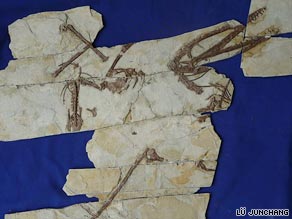What does this mean? Does this mean on one kind of animal evolves this way or a whole group of animals evolve this way over a certain time frame?
New Dino-Eating Pterosaur Evolved in Unusual Way
Oct. 13, 2009 -- An international team of researchers has just identified a new dinosaur-eating pterosaur that soared through the Jurassic skies 160 million years ago, according to a study released this week.
Christened Darwinopterus modularis, meaning "Darwin's wing composed of interchangeable units," the new flying reptile honors the 200th anniversary of Charles Darwin's birth by providing evidence for an unusual and controversial type of evolution.
Modular evolution theory holds that entire modules, or groups of body features, evolve together within a relatively short period of time.
Lead author Junchang Lu told Discovery News that the pterosaur fills a gap between primitive basal forms of this animal and more advanced pterodactyl types.
Older forms had "small heads, short necks, short wrists, a long tail and a long fifth toe on the foot," he said. In later, more derived types, "the skull, neck and wrist became relatively long, but the tail became short and the fifth toe dwindled to a small nub or was lost altogether."
Lu added: "Darwinopterus captures a moment in that evolution from primitive to advanced forms. But contrary to what we expected, it has the head and neck of an advanced pterodactyloid while the rest of the skeleton is like that of the primitive rhamphorhynchoids (flying reptiles)."....

New Dino-Eating Pterosaur Evolved in Unusual Way
Oct. 13, 2009 -- An international team of researchers has just identified a new dinosaur-eating pterosaur that soared through the Jurassic skies 160 million years ago, according to a study released this week.
Christened Darwinopterus modularis, meaning "Darwin's wing composed of interchangeable units," the new flying reptile honors the 200th anniversary of Charles Darwin's birth by providing evidence for an unusual and controversial type of evolution.
Modular evolution theory holds that entire modules, or groups of body features, evolve together within a relatively short period of time.
Lead author Junchang Lu told Discovery News that the pterosaur fills a gap between primitive basal forms of this animal and more advanced pterodactyl types.
Older forms had "small heads, short necks, short wrists, a long tail and a long fifth toe on the foot," he said. In later, more derived types, "the skull, neck and wrist became relatively long, but the tail became short and the fifth toe dwindled to a small nub or was lost altogether."
Lu added: "Darwinopterus captures a moment in that evolution from primitive to advanced forms. But contrary to what we expected, it has the head and neck of an advanced pterodactyloid while the rest of the skeleton is like that of the primitive rhamphorhynchoids (flying reptiles)."....


